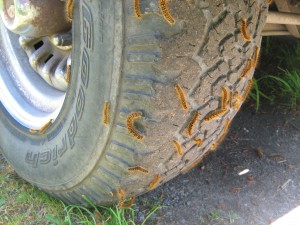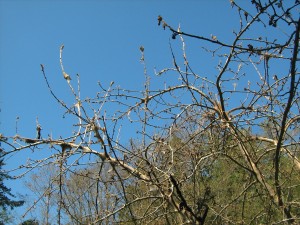by Lin McNulty
It may be climate driven, as a result of our mild winter. It may well be the result of something we don’t know about. If you are on a section of the island that is being invaded by western tent caterpillars, (Malacosoma californicum pluviale Dyar) you probably agree it is really creepy. Long-time Orcas residents say it has never been this bad in their 60-70 years on the island.
Preferred hosts are broadleaved, deciduous members of the Rose (hawthorn, apple, and rose), Willow (willow and cottonwood), and the Birch (alder and birch) families, although occasionally they are found on other plant families. WTC’s normally grow to be two inches long, are hairy with orange-yellow and black markings, and are found throughout the western U.S. Currently, caterpillars on Orcas are uncharacteristically up to three inches in length.
The larvae eat leaves and can defoliate entire branches. Mature, healthy trees can tolerate being completely defoliated and will produce a second set of leaves (usually smaller) later on. However, when trees are small or stressed such as by drought or other factors, defoliation can seriously affect tree growth. WTC overwinter as egg masses attached to branches. Eggs hatch in April and the larvae feed on leaves until they are mature. Larvae crawl up trees and buildings to pupate in fuzzy pupal cases (cocoons) in May and June. Adults emerge seven to ten days later. The light-brown adult moths mate and lay eggs that will overwinter and become next seasonʼs caterpillars.
That is the expected progression. We, however, have an unprecedented second hatch of these unwelcome visitors. Marlyn Myers, President of the Orcas Island Garden Club, says many trees are being completely defoliated—almost overnight. Whether the trees recover or not depends on the strength of the trees, whether they have an opportunity to sprout a new crop of leaves. It is an unanswered question, she says.
It may seem that some governmental agency should just step in spray, right? There a couple of reasons why this won’t work: (1) the county has an ordinance against spraying; (2) spraying should have been accomplished in April, as it is eating the sprayed leaves that kills the pest. In April, we had no idea.
A microbial insecticide, Bacillus thuringiensis var. kurstaki (B.t.), can be used (trade names Dipel, Thuricide, B.t. Caterpillar Killer, Biospray). B.t. will control caterpillars when they are young and only while they are actively feeding. B.t. is a bacterium that kills only caterpillars in the moth/ butterfly family and is safe around birds, mammals and most other insects. Caterpillars stop feeding when they are getting ready to pupate and B.t. will not control them at this point. It’s too late.
Fire is a potentially devastating prescription to the problem. Fire Chief Kevin O’Brien cautions that instructions contained in burn permits should be followed. Anyone who wishes to burn may purchase a permit online or at the Station 21 Fire Hall in Eastsound.
Birds and chickens seem to be shying away from eating the caterpillars, perhaps due to a poisonous condition. There is a wasp that may or may not appear soon that is a natural predator to the larvae. May or may not….
First food of choice for the WTC is the alder trees. They then move on to apple and cherry trees. This current infestation finds them attacking roses, rhododendrons, and even our strawberry and raspberry crops.
Other islands do not seem to be experiencing this problem. Just Orcas, although Canadian TV did run a story about the same situation in B.C., with berry crops being decimated.
There is a soft sound that accompanies this blot on the landscape. It sounds like rain. It’s not. It is the caterpillar waste dumping on the ground.
Creepy.
**If you are reading theOrcasonian for free, thank your fellow islanders. If you would like to support theOrcasonian CLICK HERE to set your modestly-priced, voluntary subscription. Otherwise, no worries; we’re happy to share with you.**










Thanks so much for this article and all the info. I live surrounded by an alder grove, and the alders are totally denuded of anything green at all. I have learned from talking with others that they, too, have never seen an infestation so bad. The ground is literally crawling with the caterpillars. They are now starting to make cocoons, which is a relief in some ways, but also, a worry for the future, apparently, given your article. Others have told me that if the alders can’t recover from being so denuded, it can create a fire hazard?–
I will never forget one morning when I went out to get into my car to go to work– the sides of all the tires of the car were literally, no exaggeration, COVERED with caterpillars. I love all the creatures and yet– I didnt even want to sit in the car. “Creepy” is just the right word. The caterpillars were gone from my tires when I got to work, but, I see now, they have indeed managed to spin cocoons in my hubcaps. As well as on the windows of…
Lopez and other islands are definitely also experiencing a peak in M. californicum population. Such population peaks can last for four years or so, but only happen every 6-11 years (as per the B.C. forest service).
A few things to add–the caterpillars are not poisonous (and don’t eat things that would make them poisonous), so the avoidance by birds (including chickens) is probably due to the irritating hairs on the ‘pillars.
The organism that lays eggs on the caterpillar heads is a tachinid fly. Look for the white eggs laid on their heads–those ones will be devoured when they begin to pupate and the fly will emerge instead of a moth.
The beasts are starting to head off to pupate, so the worst should be over by now.
The best time to control them for next year is in the winter when you can remove the egg masses themselves.
And while B.t. may be safe for mammals it kills all types of moth and butterfly caterpillars (including Island Marble and other rare and special…
Thousand Flower Farm on Waldron’s blog reported the caterpillar invasion back on May 27th:
https://thousandflower.blogspot.com/2012/05/caterpillar-invasion.html
so it’s definitely not just Orcas.
Wow! What a great diversion from all of the political enmity – finally a common enemy!
I think we should all relax. These things come in waves, cycles, unpredicted hosts, etc. Multiple factors are involved including predators,weather,disease and natural cycles, and more. It is nature. My mind goes back to 1979 when I was unable to navigate upward on the Olga Hill Road with baby daughter in front pack because the carcasses of tent caterpillars had so slicked the incline. I have a recollection of an article by Joe Long, who was the County Extension agent at the time, and wrote in the Friday Harbor Journal about the symbiotic relationship between yellow jackets and the TCs. [If you don’t remember – the yellow jackets were forcefully unbelievable tormenters at the end of last summer]. I’ve been unable to find this reference during the current infestation – and if anyone can set me straight on this, I would greatly appreciate it.
{running out of characters – will make new post]}
…..a few last thoughts.
I’m no expert, but most of the spray solutions may be too late by now. (Also – the sprays are not specific, so may effect other pollinators.) Although asthetically ugly, most healthy trees and plants will recover- otherwise – “nature’s culling”. (Can’t see that veggie gardens are affected, but could be wrong.) Lastly – pooping is big time for these worms (leaves are notoriously undigestible)so I leave you with this humble ode:
Caterpillars voiding
Auditory Illusion
Rainfall
Don’t you just love Nature!
Madrona – thanks for the accurate and timely clarifications on the biology of tent caterpillars. You know your stuff!
Thank you all for great information and sharing with us. Two years running, we’ve had a horrible time coping with the NW Tent Caterpillar. It’s been raining cat’s for about three weeks.
If you have a vegetable garden near an infested area, keep a watchful eye, cat’s are opportunistic. When they have finished with the trees they migrate… They eat more than deciduous tree leaves and berries, they enjoy lettuce, peas, etc. — They are most active late in the afternoon. Before the application of Bt. (raspberries, blueberries, fig, burning bush, etc) we often hand picked over 1,000 cat’s daily from the organic veggies. Our experience indicates Bt. is effective on large larvae, just prior to cocooning stage. If you must, best to spray Bt. early in the AM and/or late in the day. It’s not as effective to spray middle of a sunny day–UV seems to deactivate it. If you must use pyrethrum, please exercise caution. It kills bees, etc! Thank you.
Ronda Jones, passionate…
… If the cat’s have defoliated your trees/bushes/shrubs, they will stress badly during times of drought. It will help them to recover if you will provide supplemental water until the leaves return.
Ronda Jones, passionate heirloom gardener and seed saver, Orcas
I learned something important today and I thought that it would be wise to pass it along to you.
If you have trees that have been defoliated by tent worms; make sure you water them frequently because without leaves they can’t process enough moisture and they could get dry and die.
Hi, we have been visiting Orcas for decades, and are curious about THIS year’s caterpillar population–any news on THAT front? Is anyone seeing infestations now?? Thanks, Mike
Three 100+ year old apple trees infested on Culver Road property, near Shorewood. Spraying too little, too late.